Environmental Engineering Reference
In-Depth Information
3.5 Nearly 150 years of estimates of global NPP. From Smil
(2002).
Koblents-Mishke and colleagues (1968) based their ag-
gregate on data from 7,000 sites around the world, but
their total of 23 Gt C/a excluded all benthic production.
Whittaker and Likens (1975) estimated 55 Gt C, and De
Vooys (1979) put the total marine NPP at 46 Gt C/a.
The best estimates of global productivity are now derived
from satellite and surface data in combination with mod-
els of basic ecological processes. They are made possible
by remote monitoring on a planetary scale and by a bet-
ter understanding of the fundamental relations determin-
ing GPP, NPP, and R
A
.
Chlorophyll reflects less than 20% of the longest wave-
lengths of visible light, but about 60% of near IR. These
differences are easily monitored from space; LANDSAT
and SPOT offered relatively high resolution, but the high
cost of their images led to a reliance on the Advanced
Very High Resolution Radiometer (AVHRR), installed
on polar-orbiting satellites. Its maximum resolution of
only 1-4 km is sufficient to appraise large-scale patterns
of vegetation coverage and to detect seasonal and statisti-
cally significant year-to-year variability of global plant
conditions (Gutman and Ignatov 1995). The normalized
difference vegetation index (NDVI) compensated for
changing illumination conditions,
surface slope, and
viewing aspect.
The first NDVI calculations used reflectances in visible
band (0.58-0.68 mm) and in the near IR (0.73-1.1 mm);
since April 1985 they have also included brightness tem-
peratures in the thermal IR (11 and 12 mm) and the asso-
ciated observation-illumination geometry (Gutman et al.
1995). Sequential monthly averages of NDVI showed
dramatically the seasonal ebb and flow of the Earth's
photosynthesis, and the images provide an excellent tool
for monitoring changes of land cover as well as a highly
reliable input to global models of photosynthetic produc-
tivity. Similarly, satellite data from the Coastal Zone
Color Scanner have revealed global patterns of sur-
face chlorophyll (Antoine, Andr´, and Morel 1996;













































